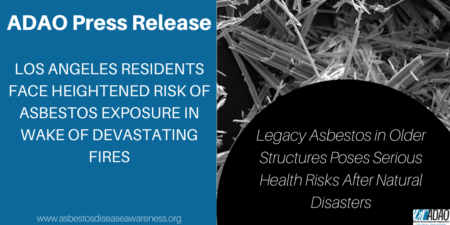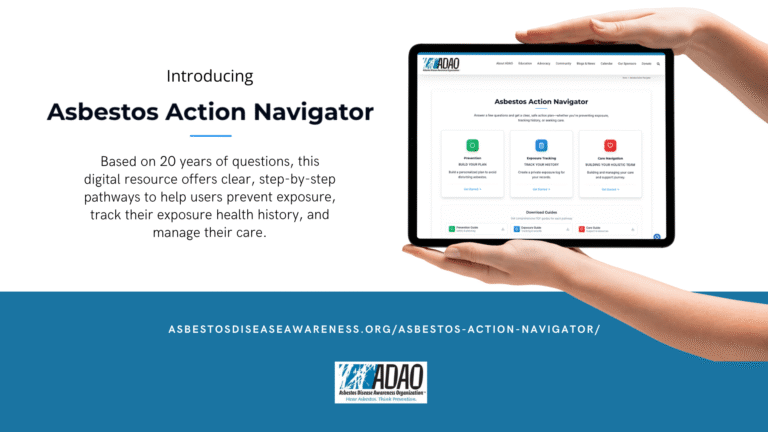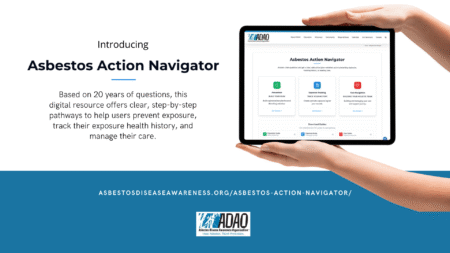FOR IMMEDIATE RELEASE
January 10, 2025
LOS ANGELES RESIDENTS FACE HEIGHTENED RISK OF ASBESTOS EXPOSURE IN WAKE OF DEVASTATING FIRES
Legacy Asbestos in Older Structures Poses Serious Health Risks After Natural Disasters
Los Angeles, CA — The Asbestos Disease Awareness Organization (ADAO), the nation’s
“With thousands displaced and homes, schools, and workplaces destroyed, the risk of asbestos exposure from fire debris, ash, and soot is significant and can have deadly consequences,” said Linda Reinstein, ADAO president and co-founder, who is a resident of Los Angeles. “Asbestos is a known human carcinogen, and there is no safe level of exposure. Taking protective measures during the cleanup and recovery process is crucial to preventing asbestos-related illnesses from developing in the future”
Asbestos was widely used throughout the United States for various purposes, including most commonly as construction insulation. Although its use has declined, it is still imported and used in the United States today. The only way to truly stay safe from asbestos is to prevent exposure from occurring.
Inhalation of asbestos fibers can lead to life-threatening diseases, including mesothelioma, asbestosis, and lung cancer.
In the wake of natural disasters like fires, floods, and hurricanes, asbestos fibers used in older structures that have been razed can become airborne, which can create serious health risks. Recognizing and mitigating these risks is critical to prevent further loss of life.
Extreme caution must be taken to protect public health when evacuation orders are lifted, and residents and community members are able to return to survey the damage of ravaged areas.
It can be unsafe to touch, breathe, or move toxic fire debris. By taking protective measures individuals have a chance to prevent the onset of asbestos-caused illness and disease.
Take precautionary steps to protect yourself and prevent accidental exposure to asbestos and other toxic debris whenever you are unsure of your environment.
Common materials that may contain asbestos include:
- Insulation
- Vinyl floor tiles
- Roofing shingles and textured ceiling treatments
- Cementitious products
ADAO urges everyone in the impacted areas to pay close attention to all warnings and alerts from public officials and closely monitor air quality.
10 Ways to Prevent Asbestos Exposure After Wildfires
- Seek Expert Assistance: If you suspect asbestos contamination on your property, promptly engage an asbestos professional. Such specialists can conduct asbestos tests, evaluate risks, and guide further action.
- Avoid Damaged Buildings: Refrain from entering damaged structures, particularly older ones. Disruptions may release asbestos fibers.
- Take Personal Protection and Decontamination Measures
- Wear, use, and dispose of Personal Protective Equipment (PPE) following guidelines for safe and secure use.
- Wear N95 masks or respirators
- Protect Others: To keep others safe, avoid carrying asbestos fibers out of a worksite where they can later be inhaled by others (e.g., by family members at home).
- Wear protective outer clothing and gloves that can be removed and discarded.
- Wash exposed parts of the body with soap and water.
- Limit Dust Generation: If you need to be in affected areas, wet the debris to curb dust. Clean with wet rags or mops and dispose of them properly afterward.
- Avoid Sweeping or Vacuuming: These actions can render asbestos airborne.
- Proper Waste Disposal: Dispose of potential asbestos-containing debris in sealed, leak-proof containers. Abide by local guidelines for the appropriate disposal of asbestos waste.
- Isolate the Area: If an area is suspected to have asbestos, restrict its access. Use barriers, barrier tape, or cones to demarcate the zone.
- Renovation & Demolition: For damaged asbestos-containing facilities, enlist a licensed asbestos removal contractor for repairs or demolition. They possess the required skills, state licensing, and tools to handle such hazards.
- Educate Others: If you’re in a leadership or influential role, disseminate this knowledge among peers, neighbors, and family to maintain communal safety
“My thoughts are with all affected residents, and my deepest gratitude goes to the tireless firefighters, first responders, and emergency teams protecting our community,” Reinstein said.
ADAO reminds residents to stay vigilant, monitor public health alerts, and prioritize safety during the recovery process. For more information, consult the Environmental Protection Agency’s publication Dealing with Debris and Damaged Buildings.
ABOUT THE ASBESTOS DISEASE AWARENESS ORGANIZATION
Founded in 2004, the Asbestos Disease Awareness Organization (ADAO) is the largest independent 501(c)(3) nonprofit in the U.S. dedicated to preventing asbestos exposure and eliminating asbestos-related diseases through education, advocacy, and community initiatives.


